A while back, I wrote an article on my top 5 iconic chronograph watches. Some of you readers wondered why Zenith wasn’t in there. Quite simply, it didn’t make my personal Top 5. However, I do love the Zenith El Primero movement, and think that its reputation as a great chronograph caliber is well-earned. So, to make it up for some of you fellow watch nerds out there, here I focus specifically on chronograph movements rather than watches.
One of my late, watch-loving friends had a special appreciation for chronographs and even ended all his e-mails with, “Chronographs, like most finer things in life, only improve with time.” If you want to know more about chronograph movements, and certain specific calibers, from a collector’s point of view, I recommend you read the interview I did with him several years ago (click here). Although it does not include the latest chronograph movements, it is still a useful article covering many important aspects of chronographs.
Another great read that I can recommend if you want to learn more about chronograph movements is the book Chronograph Wristwatches – To Stop Time, written by Gerd-Rüdiger Lang (founder and former CEO of Chronoswiss) and Reinhard Meis. The book dates from 1993 and offers good – albeit very technical – descriptions of the various chronograph movements out there.
My personal Top 10 contains in-house manufactured movements as well as mass-produced movements from manufacturers such as Lemania. You will also note that I’ve included types with both column-wheel and lever mechanisms. Other considerations include aesthetics and other attributes, all based on my experience in watch collecting over the last 15 years.
1. Zenith El Primero
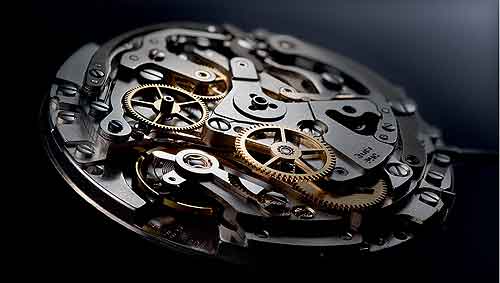
The Zenith El Primero was introduced in 1969 and the first two versions were Caliber 3019PHC (with chronograph and date) and Caliber 3019PHF (with triple date, moon-phase, and chronograph). This first automatic chronograph movement ever is a ‘fast ticker,’ with a frequency of 36,000 vibrations per hour (vph). Most chronographs at the time of its introduction were ticking at 18,000 vph or 21,600 vph. The 36,000 vph makes it possible to time intervals to 1/10th of a second. The El Primero movement as we know it today is an evolution of the very first Caliber 3019 movements. Over time, we’ve seen several brands other than Zenith using El Primero chronograph movements, including Movado, TAG Heuer, Ebel, and even some Rolex Daytonas (though Rolex made some adjustments to it). If you are really into chronographs, you need at least one watch with this movement inside it.
2. Lemania 5100
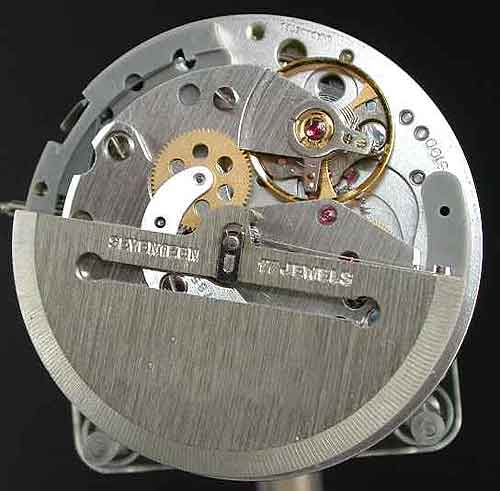
You don’t have to be a movement expert to see that this one is a rather ugly specimen. It has no column-wheel mechanism and it even has some plastic parts inside. The reason that I put this particular movement at number 2 is that it is a no-nonsense workhorse, with central second and minute chronograph hands (for easier reading), a 24-hour hand, and a day-date feature. This movement was discontinued a few years ago, which apparently brought a few chronograph collectors nearly to tears. Tutima is one of the brands that has used it for a very long time, even after the discontinuation of its production. Other brands that have used the Lemania 5100 include Omega (which calls it Caliber 1045), Sinn, Fortis, Porsche Design, and Alain Silberstein. Lemania also created its own chronograph watches in the past that contained this movement. Word is that Fortis, Sinn and Tutima used this particular movement because it was the only one at the time meeting military requirements for chronograph watches. (Photo from Watchconcept.com).
3. Lemania 2310

Another Lemania, but very different than the 5100. This Lemania 2310 is perhaps better known under Omega’s “Caliber 321” label, which was used in the very first Omega Speedmaster watches (click here). However, Omega wasn’t the only brand to use this Lemania column-wheel chronograph caliber. Even Patek Philippe used it for some of its chronograph watches, renaming it Caliber CH27-70. Of course, the Patek Philippe CH27-70 looked very different from the Omega Caliber 321 in terms of its finish, but both are based on that very same Lemania movement. Speedmaster fans crave the original Caliber 321, which Omega replaced in 1968 with Caliber 861 (also based on a Lemania movement), which had a lever mechanism instead of a column wheel. (Photo courtesy of SteveG)
4. Rolex 4130
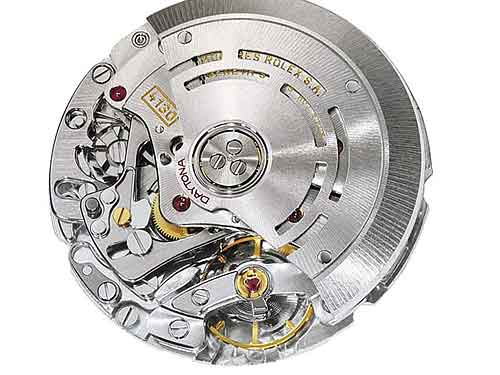
Before 2000, Rolex used hand-wound Valjoux Caliber 72 chronograph movements, and modified Zenith El Primero movements, for its Cosmograph Daytona watches. In 2000, Rolex introduced the successor to its Caliber 4030 movement (based on the El Primero), Rolex Caliber 4130. Fully developed and manufactured in-house, this automatic chronograph chronometer movement is solid as a rock and cleverly engineered. Rolex was able to reduce the number of components with a new, patented solution for the chronograph mechanism. The extra space has been used to house a larger mainspring, which increased the power-reserve capacity from 50 to 72 hours. A watchmaker from a local Rolex service center has also told me that the Daytona is quite easy for them to service thanks to this movement’s construction.
5. A. Lange & Söhne L951.6
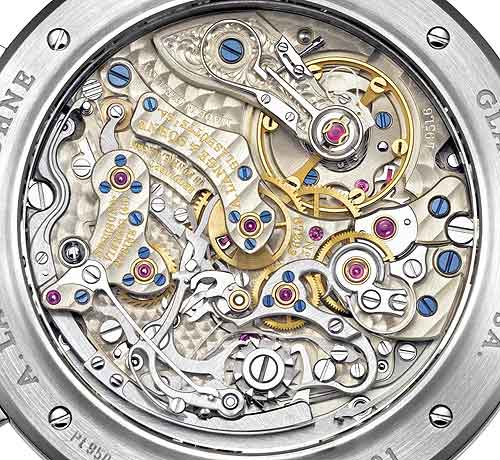
The hand-wound Caliber L951.6 by A. Lange & Söhne powers the brand’s Datograph Auf/Ab timepiece and, as you can see from the photo, has an incredibly high level of finishing and craftsmanship. The balance bridge has that traditional Glashütte finish (hand-engraving) and all the movement parts are meticulously finished as well. All the parts — even the balance spring — are manufactured in-house. This particular movement consists of 451 parts, which means assembly is surely a painstaking job for Lange’s watchmakers in Germany. Although I have much respect and admiration for all Lange movements, the one in the Datograph Auf/Ab (“Up/Down”) movement is definitely one of my favorites.
6. Omega Caliber 9300
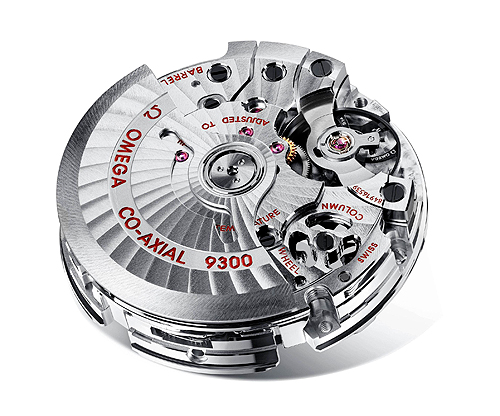
In 2011, a few years after the introduction of its in-house-developed-and-produced Caliber 8500-family of movements, Omega introduced the Caliber 9300 chronograph movement, which was also entirely developed and manufactured in-house. This impressively large caliber has the brand’s renowned co-axial escapement, a column-wheel mechanism, and a silicon balance spring. The movement has a 60-hour power reserve. So far, Omega has only used Caliber 9300 in its Seamaster Planet Ocean chronographs and Speedmaster Caliber 9300 watches, including the Speedmaster “Dark Side of the Moon.” Caliber 9300 has a two-register layout in which the subdial at 3 o’clock shows both the recorded hours and minutes. This subdial can also be used as a second-time-zone indicator if used cleverly. A review on the Omega Speedmaster 9300 can be found here.
7. TAG Heuer Caliber 1969
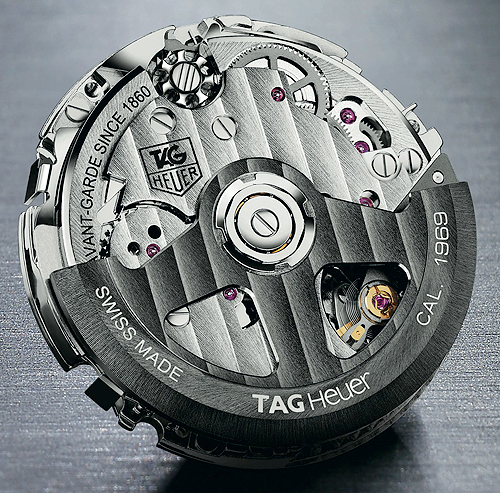
Remember the uproar when it was revealed that TAG Heuer’s Caliber 1887 movement was based on a Seiko chronograph caliber? Even though TAG Heuer modified it, and is producing it in Switzerland, the word “Seiko” lit a fire under some diehard Swiss-watch fans. Recently, TAG Heuer introduced another new chronograph movement, Caliber 1969. The caliber number refers to the year that TAG introduced its first mechanical, automatic chronograph movement, Caliber 11. And it should be noted that this movement has nothing to do with the more controversial Caliber 1887. It is a tricompax chronograph (subdials at 9, 6 and 3 o’clock) and has a power reserve of 70 hours. There are no watches available with this movement yet, as TAG Heuer just recently announced it and officially opened the production facility. I can only hope it will do a perfect re-edition of some of the classic, vintage Heuer watches that used the Caliber 11 movement in the past.
8. Patek Philippe CHR 29-535 PS Q
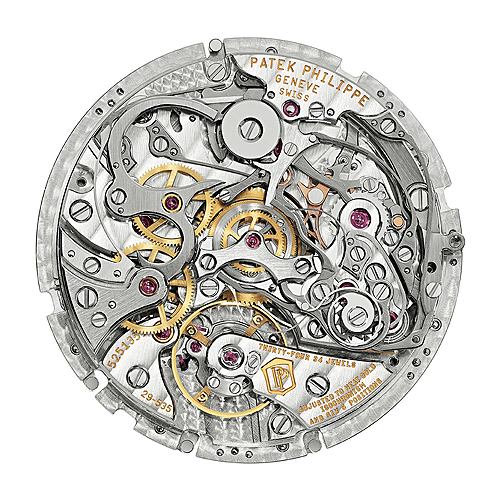
This movement, Caliber CHR 29-535 PS Q, was developed in-house by Patek Philippe. It is hand-wound and was used for the first time in Patek’s Reference 5402P (I wrote about that watch here). The movement consists of 496 parts and features not only a chronograph with split-seconds function, but also a perpetual calendar, placing it firmly in Patek Philippe’s Grand Complications collection. It is a relatively small movement compared to the others here (30 mm diameter) but quite thick. The finishing on all the parts is magnificent. Patek Philippe has filed for a patent on its new split-seconds lever construction. An amazing movement that is unfortunately — like the A. Lange & Söhne chronograph movement that came in at #5 — available only for a fortunate few.
9. Seiko Ananta Spring Drive Movement (Caliber 5R86)
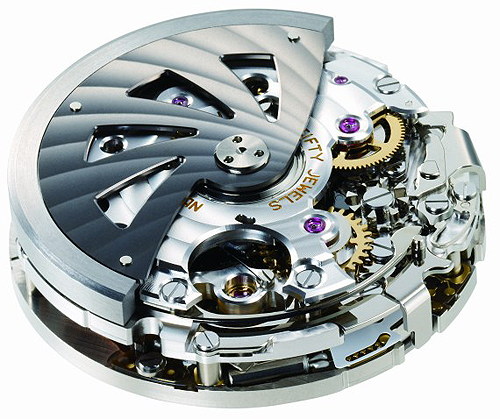
I recall that, at one point, Seiko‘s Spring Drive movement got so much publicity that people who inquired about my watch hobby were under the assumption that all watches wound by the motion of the wrist were called “Spring Drive” watches. Seiko did an excellent marketing job on that. The Ananta Chronograph was a Seiko watch that really caught my eye, with its Caliber 5R86 movement. Instead of a traditional escapement, the Spring Drive system uses a combination of a balance wheel, electro-magnetic energy, and a quartz oscillator for optimum accuracy; it uses a rotor to wind the mainspring. As you can see, the finishing is superb. If you can live without the traditional tick-tock of a purely mechanical movement, give a watch with this Seiko movement a chance.
10. Breitling B01

Following in the footsteps of Omega and TAG Heuer, Breitling also felt the urge to design and develop a chronograph movement in its own facilities. Breitling introduced its B01 chronograph movement in 2009. Before that, Breitling, like many other watch brands, used mainly ETA/Valjoux chronograph movements, along with an occasional Lemania. The Breitling B01 movement is fully developed and manufactured in-house and has a column-wheel chronograph system. It has a 70-hour power reserve and a traditional tricompax layout. It was first introduced in the Chronomat, but since then Breitling has also installed versions of it in a number of its other watches, including the Navitimer 01, Montbrillant 01 and Chronomat 44.
What are your favorite chronograph movements (not watches)? Please share them with us by leaving a comment.
This article was originally posted in 2015 and has been updated.


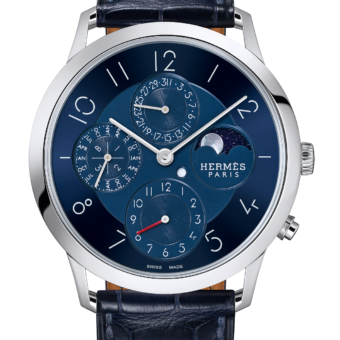


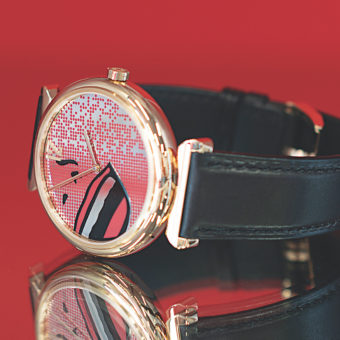

The Frederic Piguet Cal. 1185 needs a mentioned. Having powered the first Royal Oak Chronograph and the Vacheron Constantin Overseas among others, it’s an important chronograph movement.
Having had a good number of chronographs: many 7750, 2894, Glashutte Original with a module, El Primero with silicon balance etc, I think one of the best chronograph movements is the Seiko 6s28. Why they sold it off is bewildering. They should have used it in the Grand Seikos.
it is very hard to create a list of 10 classic chronograph movement and leave out the ETA/Valjoux 7750, wich is the most sold movement for mechanical chronographs, i guess its a matter of taste, but feels biased……
Looks like a random list. Why did you pick these movements against others? Breitling is horrendously inaccurate while Rolex is amazing. Do you have long term experience with any of these?
Both are COSC certified and Rolex only averages a couple more seconds a day so I don’t know where you got ” horrendous” from.
Should the F. Piguet 1185 be mentioned?
Absolutely love my Zenith El Primero but the Patek and A Lange & Sohne are stunning.
I have a Glashutte
Original calibration 37 which is excellent yet it never seems to be considered. Is there a reason for that?
I wan’t more technical information about the Tag Heuer Chronograph
heeft u afbeeldingen van Lemania 1873
JLC 919
Recently, TAG Heuer introduced another new chronograph movement, Caliber 1969. The caliber number refers to the year that TAG introduced its first mechanical, automatic chronograph movement, Caliber 11.
The Breitling Chronomat 44 GMT 2-TONE BRACLET watch is my one only watch. You neef three Rolex’s to do what this on watch does. The biild quality is superior to Rolex as well. The bezel, case, bracelet, crystal, power reserve, jewels, water resistance, date wheel all are far superior to Rolex or any other sport watch on the market. Barter why you buy and one will not be hurt so much if one feels incline to sell (why?).
Why not update this rather than regurgitate an old article? The 1969 calibre for example has since morphed into the CH80 and then again into the Heuer 02. With these changes have come done substantial mods. It now has less parts than any chrono made. This is one. Love the article but it’s been reading years before.
What about Eterna Calibre 39? Or the Eterna Calibre 6036, with a mechanical digital chronograph?
Hi, Wondering why the ULYSEE Nardin UN-118 Calibre which is COSC COMPLIANT not in the top 10? Considering with the silicon Internals where no lubrication is required therefore less maintenance. Plus a 60 hr power reserve.regards Paul
Is 2018 man
Seiko 9S86 is here to say hello
Find it hard to justify a list of chronograph movements without including the Longines 30CH.
I do not know all of these movements personally. All my watches with the Valjoux 72 and the Venus 178 movements function exceptionally well. Their accuracy far exceed COSC standards and none of them has ever broken down.
Chronograph with sweep seconds and minates up to 60 are the only ones easy to read, therefore, the Lemania is my preference. My Th time beats the others.
how could you leave out the 7750?
I need more info about watches
How do oneself appreciate or compare a watch movement without being given or told of the specs? I mean, I could understand car engines, you’d definitely experience differences between a 318i against an M3, a C180 against a C63, but watch movements?
Elprimero Zenith.
Omega Cal. 1040 should be on top list! Better than 1045 I think. Valjoux 7750, Cal. 861 Omega, Venus 178, Val 72!
are you confident that the Lemania 5100 does not have a column wheel and vertical clutch system?? Here you can see both: http://forums.watchuseek.com/f2/who-produced-first-automatic-chronograph-256831-8.html
What about the caliber Valjoux 7750? I presume there is no other modern caliber for watches with chronograph functions than that.
In my experience, the Valjoux 7750 is flawed. I have owned watches of top brands with that movement and they all malfunction. If you activate the chrono and stop and start it several times over a period of a few hours the chrono hours register will fail to reflect what it is supposed to measure correctly.
As a frequent traveler I rely on and greatly enjoy Breitling’s B04 movement with the GMT function as well as their B05 Unitime movement
Both are renditions derived from tbe b01
Howdy,
I’m a bit surprised at the ordering here… are you awarding the most complex movements or the best functioning? From what I’ve read it seems the Seiko mvmnt slaps down most of the other on accuracy. Are there additional complications on the other movements that makes them better for some reason? Are we going based on price? What’s the deal?!?
I’m sure you have good reasons for having a ranking system here, but it isn’t really clear what they are. I have a feeling that most people don’t give a rats bottom about your gut feeling. If you actually had some reasoning behind what makes a chrono mvmnt better than others — that would at least be something. For watch movements I could really care less about what people think about them, gimme cold hard facts about why this movement is great… It keeps great time… It has additional complications… it has a low service cost… something for crickity sakes!
Sorry if this came off as rude, as that wasn’t the intent. I just want some better reading :)
Cheers!
Hi, to quote the author: “My personal Top 10 contains in-house manufactured movements as well as mass-produced movements from manufacturers such as Lemania. […] I’ve included types with both column-wheel and lever mechanisms. Other considerations include aesthetics and other attributes, all based on my experience in watch collecting over the last 15 years.” – hope that answers your question.
Hard to believe the IWC Calibre 89361 in house move went isn’t included. Column wheel, vertical clutch and beautiful finish.
Where is the F. Piguet 1185?!? it’s the basis for every Blancpain chrono, was used by VC in the Overseas chrono, as well as Cartier Pasha, etc… and is still being used in the AP RO chrono!
I agree F.Piquet is an amazing movement Omega did use in their coaxial escapement as caliber 3203
I have just bought an old Omega Genevé watch from a pawn shop in Newark. On
opening it I found the beautifully made
automatic 565 movement it runs very
well and look lovely to wear, with the
minimalist dial.
and is a
Hi Robert,
Some nice movements here and I love both the ALS 951.6 as well… likewise for the Patek CHR 29-535 PS Q!
I’ve just recently purchased a Breitling Transocean 1984 with the B01 movement. Must admit that I’ve not had a lot of experience with this particular brand or the movement. So, I’m hoping it’ll turn out to be a classic movement with great longevity and accuracy! :)
But, in asking people’s opinions about what qualifies as a “classic movement” I’m sure there are opinions, opinion, and opinions. They’re sort of like belly-buttons… everyone has one!
So, I’m glad to see your question and request, “What are your favorite chronograph movements (not watches)?”
Cheers!
Capo
How can the 1861/3 not be a classic?
hahahaha. you are just being a snob. those are nice, expensive movements. But the real workhorse and owned by many people, more than all your top ten combined is the valjoux 7750. the valjoux 7750 has been powering a lot of watches since its inception. adopted by many watchmakers like IWC, Omega, Breitling and many many more and yet you fail to mention it?
If you love Breitling then the Venus 178 has to be on the list.
I second that. Beautiful and it keeps time as good as anything I have ever owned. My 69 Navitimer will not need an adjustment in 6 (six) months if I wear it everyday.
Hamilton Pan Europ caliber 11sx Mine
Hi Robert-Jan,
I love the El Primero (have many, one 4003 perpetual), love the Breitling B01, the Rolex 4130, I am impressed by the Lemania/Ebel 137 movement and love them all to pieces in my collection. Even the old Valjoux 7750 should be in the list as well I believe, it is a great old work horse.
Very good post :) I love chronograph watches i have collection from Universal Geneve chronographs.
Between i have 2 chronographs
Not really a great article, but still some great movements, and even greater movements are missing!! There are so manny different kind of chronograph movements. So which are exactly covert by this article or just all stacked together.
If so than where is for example Longines (13ZN 30CH) to just name one. Too bad many of these blog pretend to be experts and unknowingly (and of course unintentionally) create more ‘great’ lists. In the end there is so much written about nice chronograph movements. Even more off-line than online.
Still great movements are mentioned in this list! :)
WHERES EXCELSIOR PARK AND VENUS 178 oh and don’t forget ANGELUS now you know why im not a subscriber Co Axial with breakable escapement should NOT be there I had 2 both broke after minor hit COST TO REPAIR???? you tell me so I got mad and threw it out BOTH and as for the patek phillipe chronograph????? Yes THE new ones YOURE supposed to be the expert so u tell me
I don’t know what makes a movement tops. But, from an appearance standpoint, the A. Lange & Sohne and the Patek are just works of art!
Agreed
I brought my Zenith El Primero Chronomaster in 1996 in Italy and have had it serviced twice only. When I am not wearing it I keep it in a self winding box so in all those years it’s never really stopped. Still keeps perfect time and still looks good.
That’s good to know! I just bought a Zenith Pilot Annual Calendar chrono 48mm and can’t seem to take it off my wrist. I will also grab a cafe racer when those are available.
Seiko 6139/6138 vertical clutch / column wheel chronograph?
Yep, hard to dismiss those, especially from a value standpoint.
Well, I must take issue with what constitutes top 10 – are you addressing: initial cost per movement, cost of service over ten years, non-availability of replacement parts and difficulty in service as the benchmark for the top ten? – then you have certainly hit the nail on the head. Yes, the lowly 7750,51,73 Valjoux’s are available to anyone at the Swatch window and their service support is wonderful / initial cost is low, and the longevity of the movement is well tested in time. What about listing the bottom ten chronographs, perhaps including the Quartz, excuse me they may prove to be too accurate, honestly, you have snubbed Valjoux for a good reason other than its merit to the vast number of owners worldwide. What was your reason, anyway?
Here Here!
valjoux 7750 is great movement, with both date and day window
Personally, though I love the Rolex 4030 and 4130 I have a special place in my heart for the Lemania 1873. Just a really well designed no nonsense movement and fun to work on. Chronographs are my favorite movements to service (other than the ETA 7750 of course)
Love the AL&S 951.6
I also include the Breitling Transocean, with the in-house calibre B01.
I would include among top chronograph watches from two brands: Tag Heuer – the two in-house movements 1887 and 1969 – and from Seiko, the Ananta 100th Anniversary, with hand painted blue dial.
Hello Robert,
I am somewhat surprised that you did not include Seiko (specifically Grand Seiko) as part of your top 5. In my opinion, they are on par with the best of the swiss watch makers.
Thanks for your great articles. I enjoy them all.
Best regards,
Jim